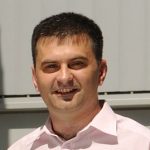
The Power Electronics Research Laboratory (B310) is equipped with the following main laboratory equipment:
During this period, a system for the production of electricity will be investigated, which as potential sources of electricity includes a wind turbine (WT) with a self-excited induction generator (SEIG), a photovoltaic (PV) system, and batteries. The proposed system will be investigated both in the standalone and grid-tied mode. Research planned to be conducted over the next five years can be divided into the following guidelines:
1. Research in the field of SEIG control system
The integration of the sensorless SEIG vector control system with the PV system will take place based on previously conducted simulation and experimental research. The estimation of the SEIG speed will be based on the Model Reference Adaptive System (MRAS). The induction generators that will be considered differ with regard to construction (aluminum / copper rotor cage) and also with regard to the efficiency class (IE1 / IE3). An analysis of the impact of the complexity of the utilized SEIG mathematical model on the speed estimation accuracy and dynamic performance indicators will be conducted.
2. Research in the field of PV systems
The research will be conducted on a quasi Z-source inverter powered by a PV system. The focus of the research will be on finding the maximum power point of the PV system at different temperatures and irradiances, as well as under partial shading conditions.
3. Research in the field of battery system modeling
Theoretical and experimental research of the existing battery system will be carried out in order to determine its parameters. An algorithm will be developed to track the state of charge (SOC) of the batteries during system operation.
4. Power flow management in the analyzed electricity generation system
Strategies for managing the power flow of the entire system will be developed taking into account the available power from the PV and WT systems, and also the SOC of the battery system. Standalone and grid-tied operation modes will be individually analyzed, as well as transitions between these two modes of operation.